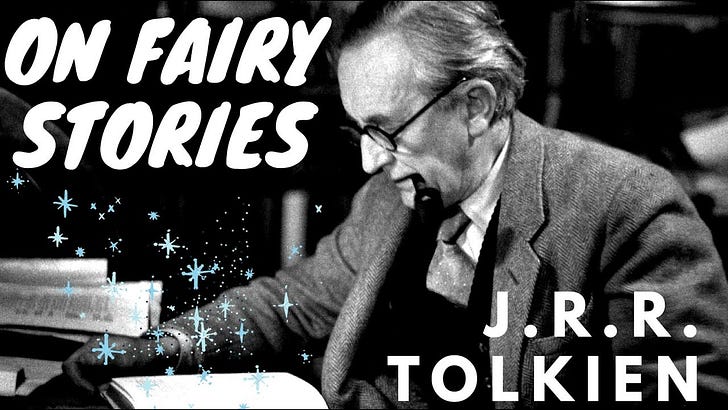There is a lot of talk about fantastic adventure literarure and the place that J.R.R. Tolkien has in it. The Just So story is that Tolkien invented it. This is disprovable on a cursory examination of contemporaries and predecessors to The Hobbit’s publication.
Therefore there is need for a deeper consideration. Tolkien, thankfully, left behind his own words on the matter with On Fairy Stories. Below is an executive summary; there are a lot of essays and podcasts on the book and its contents, which I encourage you to read and watch/listen at your earliest convenience.1
I would like for you to entertain the idea that Tolkien’s Middle-Earth stories, starting with the aforementioned Hobbit and going through The Lord of the Rings to all of the follow-ons such as The Silmarillion and more, as fairy tales and not “Fantasy”.
Why?
Because “Fantasy” includes Howard’s Conan, Kull, Bran Mac Morn, and more. Well before 1980, we had writers trying to recapture and building up Howard’s Conan tales (e.g. Charles Saunders with Imaro), we had latter-day Sword & Planet stories that (like Burroughs) said “Screw Your Fake Genre Lines” for the sake of telling a thrilling tale, and we had historical fantasies that owe more to 19th century dime novels than Tolkien.
In that massive mound of manuscripts you find a variety of stories. Some are crime dramas that feature heists, some are historically-inspired grand drama that wouldn’t be out of place next to Anabasis or Romance of the Three Kingdoms, some are self-indulgent tales that may not be true, and more variations that—in a competently-organized publishing industry—would recognize these differences and sift them accordingly like we do now with film and television most of the time.
Then Lester Del Ray showed up.
As noted last week, he took Terry Brooks’ Shannara and called that “Tolkien-style”. Then he made it into a MadLib template that he imposed by editorial fiat, forcing all into that mold whether it fit or not. Combined with the Black Swan event that was the Thor Power Tool decision and you had the ingredients for creating an original that never existed.
That original is not Tolkien. That original is the myth of Tolkien The Fantasist, a myth that Del Ray deliberately fostered and cultivated into an egregore: a non-physical entity or thoughtform that arises from the collective thoughts and emotions of a distinct group of individuals. In this case, “Fantasy” publishers, editors, and cult-like readers- the counter-party to the “Science Fiction” egregore.
These egregores are the source for the literary Stand-Alone Complex. They are the Gork and Mork of Fandom, and thanks to the aforementioned US Supreme Court decision enabling the destruction of popular literature we had that hard continuity break by 1980, coupled with the generational turnover in the New York and London publishing establishment, that ensured the ascent of these egregores as Received Wisdom and thus normalized worldwide.
This is why “Fantasy” and “Science Fiction” existed for as long as they did: they made a cult idol out of a myth, pointed to that idol as the original, and others accepted it due to a lack of information. Those others acted on their belief, performing a series of independent acts that—from the outside—look like coordinated action when it was not. Even after accounting for the active manipulations, great and small, that did occur you still have this belief born of this false perception that people act upon- one need only look at the piles of Pink Slime Fantasy slop out there (before the cosplay smut took over).
Remember the media environment of the 1970s. No social media. No Internet. No real-time communications over intercontinental distances for anyone that wasn’t working for a government agency or its corporate counterpart. Mass media was unidirectional and centralized, increasingly so, making it very easy for a small number of people to dictate norms to millions.
That is what Lester Del Ray did to create “Fantasy”, and how he did it, copying what John W. Campbell did 40 years before to create “Science Fiction”. The SCOTUS ruling just made the task far easier to accomplish in far shorter a period of time. It was ever only a thing possible to accomplish and maintain when you had that degree of media control, and it is not surprising that now we see it being disenchanted as that control collapses due to decentralized media environments overtaking the old centralized one.
In short, as with the SCOTUS decision, it is again a Black Swan that is ending what the previous one enabled and accelerated.
Next week we’ll get into the meat of the mythology behind the egregore powering this Stand-Alone Complex.



